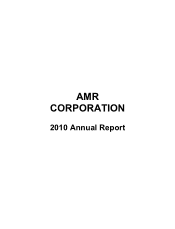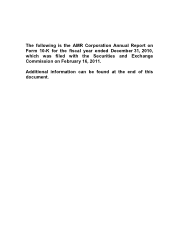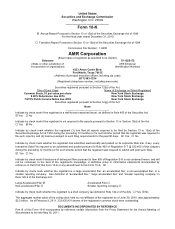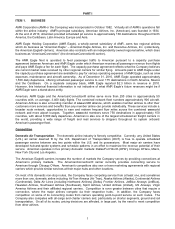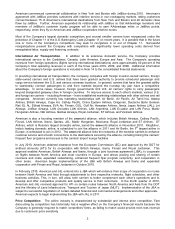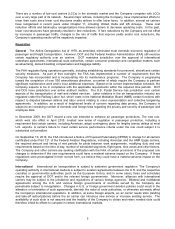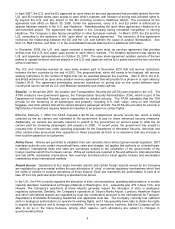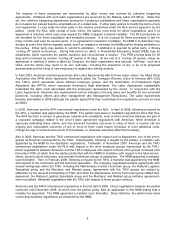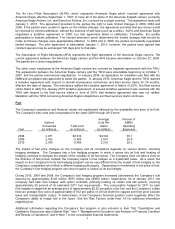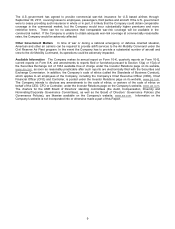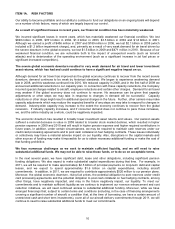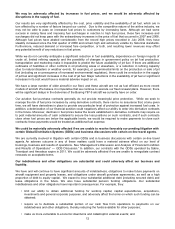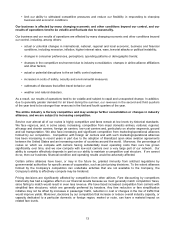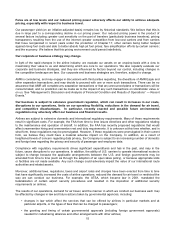American Airlines 2010 Annual Report Download - page 10
Download and view the complete annual report
Please find page 10 of the 2010 American Airlines annual report below. You can navigate through the pages in the report by either clicking on the pages listed below, or by using the keyword search tool below to find specific information within the annual report.
7
The Air Line Pilots Association (ALPA), which represents American Eagle pilots, reached agreement with
American Eagle effective September 1, 1997, to have all of the pilots of the American Eagle® carriers (currently
American Eagle Airlines, Inc. and Executive Airlines, Inc.) covered by a single contract. This agreement lasts until
January 1, 2013. The agreement provided to the parties the right to seek limited changes in 2000, 2004 and
2008. If the parties were unable to agree on the limited changes, the agreement provided that any issues would
be resolved by interest arbitration, without the exercise of self-help (such as a strike). ALPA and American Eagle
negotiated a tentative agreement in 2000, but that agreement failed in ratification. Thereafter, the parties
participated in interest arbitration. The interest arbitration panel determined the limited changes that should be
made and these changes were appropriately effected. In 2004 and in 2008, the parties successfully negotiated
limited changes. The pilot agreement is amendable January 1, 2013; however, the parties have agreed that
contract openers may be exchanged 120 days prior to that date.
The Association of Flight Attendants (AFA) represents the flight attendants of the American Eagle carriers. The
current agreement between the American Eagle carriers and the AFA became amendable on October 27, 2009.
The parties are in direct negotiations.
The other union employees at the American Eagle carriers are covered by separate agreements with the TWU.
The agreements between the American Eagle carriers and the TWU were amendable beginning on October 1,
2007, and the parties commenced negotiations. In January 2009, an application for mediation was filed with the
NMB and a mediator was appointed to assist the parties. In January 2010, American Eagle and the TWU reached
a tentative agreement with respect to aircraft maintenance technicians and fleet service clerks for 24 months,
effective the date of signing. The mechanics ratified the tentative agreement in March of 2010. The fleet service
clerks failed to ratify the January 2010 tentative agreement. A second tentative agreement was reached with the
TWU with respect to the fleet service clerks in June of 2010; that tentative agreement also was not ratified.
Mediation with the TWU concerning American Eagle’s dispatchers and fleet services clerks continues.
Fuel
The Company’s operations and financial results are significantly affected by the availability and price of jet fuel.
The Company's fuel costs and consumption for the years 2008 through 2010 were:
Year
Gallons
Consumed
(in millions)
Total Cost
(in millions)
Average
Cost Per
Gallon
(in dollars)
Percent of
AMR's
Operating
Expenses
2008
2,971
$9,014
$3.034
35.1
2009
2,762
5,553
2.010
26.5
2010
2,764
6,400
2.316
29.3
The impact of fuel price changes on the Company and its competitors depends on various factors, including
hedging strategies. The Company has a fuel hedging program in which it enters into jet fuel and heating oil
hedging contracts to dampen the impact of the volatility of jet fuel prices. The Company does not take a view on
the direction of fuel prices; instead, the Company layers in fuel hedges on a systematic basis. As a result, the
impact on the Company from its fuel hedging program can be very different from the impact of fuel hedging on the
Company’s competitors who follow a different hedging philosophy. Depending on movements in the price of fuel,
the Company’s fuel hedging program can result in gains or losses on its fuel hedges.
During 2010, 2009 and 2008, the Company’s fuel hedging program increased (decreased) the Company’s fuel
expense by approximately $142 million, $651 million and ($380) million, respectively. As of January 2011, the
Company had cash flow hedges, with option contracts, primarily heating oil collars and call options, covering
approximately 35 percent of its estimated 2011 fuel requirements. The consumption hedged for 2011 by cash
flow hedges is capped at an average price of approximately $2.52 per gallon of jet fuel, and the Company’s collars
have an average floor price of approximately $1.92 per gallon of jet fuel (both the capped and floor price exclude
taxes and transportation costs). A deterioration of the Company’s financial position could negatively affect the
Company’s ability to hedge fuel in the future. See the Risk Factors under Item 1A for additional information
regarding fuel.
Additional information regarding the Company’s fuel program is also included in Item 7(A) “Quantitative and
Qualitative Disclosures about Market Risk,” Item 7 “Management’s Discussion and Analysis of Financial Condition
and Results of Operations” and in Note 7 to the consolidated financial statements.

